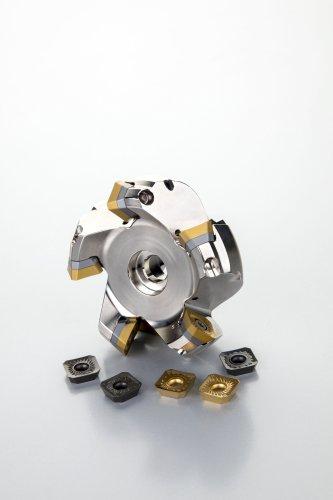Contact Details

A new assortment of versatile face milling inserts has been launched by Dormer Pramet.
The global manufacturer has added five variants of square shaped positive inserts for depths of cut up to 6.4 mm to its Pramet brand. The range is suitable for a variety of general engineering and maintenance and repair operations (MRO) machining, with several application-specific geometries and grades available for machining any workpiece material.
The Pramet SDMT 13 pressed inserts are designed with economy in mind. Its M geometry is designed for light and medium cuts, while R geometry is focused more on roughing. Both geometries are versatile for milling steels, cast irons and hard steels.
The Pramet SDET 13 precision ground inserts are dedicated for usage in specific workpiece material groups. Sharp F geometry is the ideal choice for secure machining of stainless steels and heat resistant super alloys. A polished, extra sharp FA geometry allows for productive machining of non-ferrous materials. An additional wiper insert XDET 13 is also available to provide high surface quality in larger diameter cutters and high feed rates.
A wide assortment of cutters is available to support new range of inserts. The (I)SSD13F comes in Weldon and Shell styles, with a wide range of sizes 32 – 250 mm (1.25 – 10.00 inch).
A carbide shim on the insert seating gives extra stability and process security, while protecting the cutter body for high durability. These new cutters also utilize internal coolant delivery for improved chip evacuation to achieve high surface quality.
Related Glossary Terms
- alloys
alloys
Substances having metallic properties and being composed of two or more chemical elements of which at least one is a metal.
- cast irons
cast irons
Cast ferrous alloys containing carbon in excess of solubility in austenite that exists in the alloy at the eutectic temperature. Cast irons include gray cast iron, white cast iron, malleable cast iron and ductile, or nodular, cast iron. The word “cast” is often left out.
- coolant
coolant
Fluid that reduces temperature buildup at the tool/workpiece interface during machining. Normally takes the form of a liquid such as soluble or chemical mixtures (semisynthetic, synthetic) but can be pressurized air or other gas. Because of water’s ability to absorb great quantities of heat, it is widely used as a coolant and vehicle for various cutting compounds, with the water-to-compound ratio varying with the machining task. See cutting fluid; semisynthetic cutting fluid; soluble-oil cutting fluid; synthetic cutting fluid.
- feed
feed
Rate of change of position of the tool as a whole, relative to the workpiece while cutting.
- gang cutting ( milling)
gang cutting ( milling)
Machining with several cutters mounted on a single arbor, generally for simultaneous cutting.
- milling
milling
Machining operation in which metal or other material is removed by applying power to a rotating cutter. In vertical milling, the cutting tool is mounted vertically on the spindle. In horizontal milling, the cutting tool is mounted horizontally, either directly on the spindle or on an arbor. Horizontal milling is further broken down into conventional milling, where the cutter rotates opposite the direction of feed, or “up” into the workpiece; and climb milling, where the cutter rotates in the direction of feed, or “down” into the workpiece. Milling operations include plane or surface milling, endmilling, facemilling, angle milling, form milling and profiling.
- stainless steels
stainless steels
Stainless steels possess high strength, heat resistance, excellent workability and erosion resistance. Four general classes have been developed to cover a range of mechanical and physical properties for particular applications. The four classes are: the austenitic types of the chromium-nickel-manganese 200 series and the chromium-nickel 300 series; the martensitic types of the chromium, hardenable 400 series; the chromium, nonhardenable 400-series ferritic types; and the precipitation-hardening type of chromium-nickel alloys with additional elements that are hardenable by solution treating and aging.
- wiper
wiper
Metal-removing edge on the face of a cutter that travels in a plane perpendicular to the axis. It is the edge that sweeps the machined surface. The flat should be as wide as the feed per revolution of the cutter. This allows any given insert to wipe the entire workpiece surface and impart a fine surface finish at a high feed rate.





